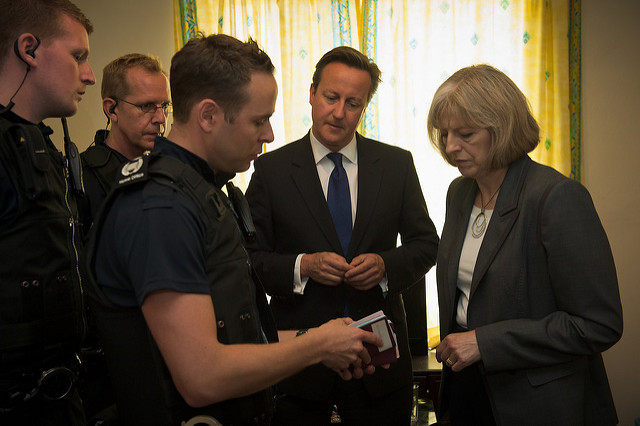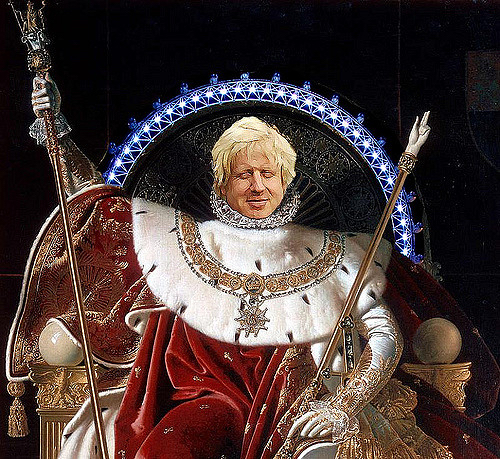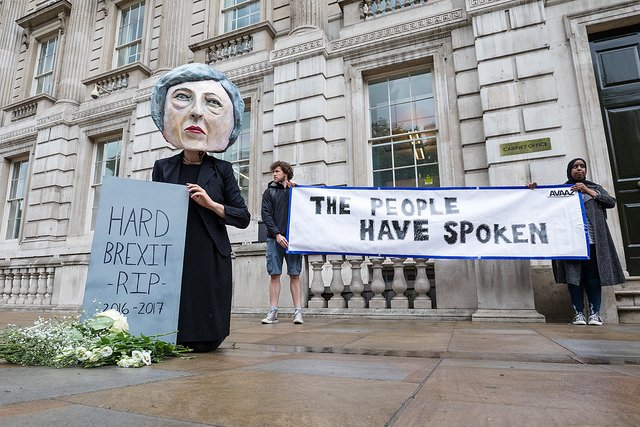Understandably, a lot of people see Theresa May’s populist turn as a sharp turn to the extreme right. The Nasty Party is back! This is a new kind of poujadism, as you’ve read in Jacobin. Her last speech was just less threatening than in the original German, or so I’m told. Yet the truth doesn’t wear jackboots. Perhaps the new government is hoping it can talk right and carry on walking in the centre.
Despite appearances the Conservative establishment is far from united on the European question. Theresa May has had to pour ice water over Liam Fox and David Davis for talking up a hard Brexit. The British ruling-class has every reason to want to maintain its current economic arrangements with the European Union. Finance capital benefits from its access to international markets and the EU is the biggest economic bloc in the world.
At the same time, the May government has to satisfy the hard-right eurosceptics, who want to break out of the single market, close the borders and turn towards the US. However, the Tory base is not just middle-class homeowners, it’s the City and the business community above all else. These constituents could have easily lived with EU membership. So there are powerful incentives for May to find a soft Brexit, but this can’t be done without serious trouble.
Today Thatcherism and Blairism are both exhausted. So May is trying to reinvent the centre-ground as a more nationalist status quo. The social base for a strong centre is no longer present in British politics. This is why the Blairites have lost Labour to the Left. Theresa May has had to abandon the budget surplus as an end-in-itself. Instead we’re told cutting the deficit is no longer appropriate, though it was a fine aim for the last six years.
The Centre as Conservatism
Himself a former austerity hawk Philip Hammond is now talking up a stimulus package for infrastructure. He warned the UK to prepare for a rocky ride. Hammond even went on a charm offensive to reassure the banks. This was the end of the Cameron era. George Osborne‘s 2020 target of a budget surplus has been written-off, as if it were actually going to met in the first place. A decade of Tory politics has been dismantled in less than six months. But this should not surprise us.
David Cameron’s agenda was to transform the Conservative Party to fit the New Labour playbook. It’s all public relations, decaff policy initiatives, polling and focus groups – all show, no substance. Early on the Conservatives picked up the idea of the ‘Big Society‘, as they sought a new justification for handing over state assets to the private sector. The idea was you could hand over assets to communities. This was the basis for the so-called ‘free schools‘.
The ‘Big Society’ vanished circa 2013 as Osborne moved away from the harshest cuts to bolster growth. He did this by relying on printing billions of pounds to funnel into Canary Wharf, and inflating a new housing bubble. Meanwhile the original target of a budget surplus by 2015 was quietly dropped. In other words, the Cameron government tried to recreate the same boom that went bust under Gordon Brown.
Since the IMF bailout of 1976 the UK has remained on the same track running the neoliberal circuit with little deviation. The social conditions have changed a great deal in 40 years. A housing crisis has killed the idea of mortgages as a gateway to middle-class life. Trade unions are greatly diminished. Debt has filled the gap in the absence of rising wages. The centre is the most conservative position in this situation.
The New Order
This is where Theresa May stands today. But her weapon of choice is an old one. It goes back to Disraeli, when the Conservative Party had to find new ways to defeat the Liberals. The 1867 Reform Act expanded the size of the electorate by over 2 million, as more working-class men got the right to vote. The Conservatives were forced out of office, and Disraeli sought out Tory nationalism as a means of winning over less affluent voters.
Except May is looking to soften the Conservative message on the economy and toughen language on immigration. She hopes to keep Britain in the single market and restrict EU immigration. This is a way of bypassing the choice of hard or soft Brexit. Whether or not the May government can get the concessions from Europe is another matter. Right now, May is focused on Tory unity. It’s all about shoring up the base for the turbulence ahead.
So what should we expect from the new era? Well, we can be sure to see more of the same, but in a more extreme form. We can expect more anti-immigrant posturing, and more red-meat for middle-class voters. Grammar schools are just one example of what is to come. Almost certainly May will build on past counter-terror measures to further limit civil liberties. The new government may well play up the idea of a British Bill of Rights as it puts EU law through the shredder.
It’s possible that the May government will have to try to answer a series of constitutional problems. These answers will play to right-wing fantasies. The real test will come next year when Article 50 is invoked, and the negotiations begin. Everything is on the line, from the UK economy to the future of the Union itself. If May fails the test of Brexit, it won’t be the British people who get rid of her. The Tories will move quickly, daggers drawn.
Photograph courtesy of Number 10. Published under a Creative Commons license.





